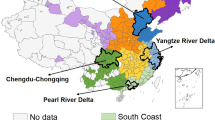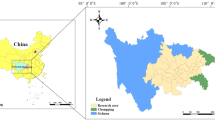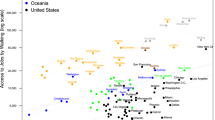Abstract
The role of transportation network companies (TNCs) in the urban transport system is under intense debate. In this study, we systematically assess three aspects of the net impacts of TNCs on urban mobility in the United States—road congestion, transit ridership and private vehicle ownership—and examine how these impacts have evolved over time. Based on a set of fixed-effect panel models estimated using metropolitan statistical area level data, we find that the entrance of TNCs led to increased road congestion in terms of both intensity (by 0.9%) and duration (by 4.5%), an 8.9% decline in transit ridership and an insignificant change in vehicle ownership. Despite the ideal of providing a sustainable mobility solution by promoting large-scale car sharing, our analysis suggests that TNCs have intensified urban transport challenges since their debut in the United States.
This is a preview of subscription content, access via your institution
Access options
Access Nature and 54 other Nature Portfolio journals
Get Nature+, our best-value online-access subscription
$29.99 / 30 days
cancel any time
Subscribe to this journal
Receive 12 digital issues and online access to articles
$119.00 per year
only $9.92 per issue
Buy this article
- Purchase on SpringerLink
- Instant access to full article PDF
Prices may be subject to local taxes which are calculated during checkout

Similar content being viewed by others
Data availability
The TNC entry time datasets are available from the corresponding author on request. The publicly accessible databases on public transit ridership, congestion, GDP, population, household median income and unemployment rate can be downloaded at: (1) National Transit Database (NTD): https://www.transit.dot.gov/ntd/ntd-data; (2) Federal Highway Administration (FHWA): https://ops.fhwa.dot.gov/perf_measurement/ucr/; (3) Bureau of Economic Analysis (BEA): https://www.bea.gov/data/gdp; (4) American Community Survey (ACS): https://www.census.gov/programs-surveys/acs/data.html.
References
Batty, M. The size, scale, and shape of cities. Science 319, 769–771 (2008).
Bettencourt, L., Lobo, J., Helbing, D., Kuhnert, C. & West, G. Growth, innovation, scaling, and the pace of life in cities. Proc. Natl Acad. Sci. USA 104, 7301–7306 (2007).
Bettencourt, L. The origins of scaling in cities. Science 340, 1438–1441 (2013).
Vuchic, V. Urban Transit: Operations, Planning, and Economics (John Wiley & Sons, 2017).
Habitat III: Third United Nations conference on housing and sustainable urban development. J. Educ. Sustain. Dev. 9, 125 (2015).
Mitchell, W., Borroni-Bird, C. & Burns, L. Reinventing the Automobile: Personal Urban Mobility for the 21st Century (MIT Press, 2010).
Parry, I., Walls, M. & Harrington, W. Automobile externalities and policies. J. Econ. Lit. 45, 373–399 (2007).
Cohen, B. & Kietzmann, J. Ride on! Mobility business models for the sharing economy. Organ. Environ. 27, 279–296 (2014).
Drut, M. Spatial issues revisited: the role of shared transportation modes. Transp. Policy (Oxf) 66, 85–95 (2018).
Hamari, J., Sjöklint, M. & Ukkonen, A. The sharing economy: why people participate in collaborative consumption. J. Assoc. Inf. Sci. Technol. 67, 2047–2059 (2016).
App-Based Ride and Taxi Services: Principles for Regulation (OECD/ITF, 2016).
Taylor, B. et al. Between Public and Private Mobility: Examining the Rise of Technology-Enabled Transportation Services; Special Report 319 (Committee for Review of Innovative Urban Mobility Services, Transportation Research Board, The National Academy of Sciences, 2016).
Santi, P. et al. Quantifying the benefits of vehicle pooling with shareability networks. Proc. Natl Acad. Sci. USA 111, 13290–13294 (2014).
Alonso-Mora, J., Samaranayake, S., Wallar, A., Frazzoli, E. & Rus, D. On-demand high-capacity ride-sharing via dynamic trip-vehicle assignment. Proc. Natl Acad. Sci. USA 114, 462–467 (2017).
Vazifeh, M., Santi, P., Resta, G., Strogatz, S. & Ratti, C. Addressing the minimum fleet problem in on-demand urban mobility. Nature 557, 534–538 (2018).
Shared Mobility and the Transformation of Public Transit (American Public Transportation Association, 2016); https://www.apta.com/wp-content/uploads/Resources/resources/reportsandpublications/Documents/APTA-Shared-Mobility.pdf
Shaheen, S. & Chan, N. Mobility and the sharing economy: potential to facilitate the first- and last-mile public transit connections. Built Environ. 42, 573–588 (2016).
Jin, S., Kong, H., Wu, R. & Sui, D. Ridesourcing, the sharing economy, and the future of cities. Cities 76, 96–104 (2018).
Hoffmann, K., Ipeirotis, P. & Sundararajan, A. Ridesharing and the Use of Public Transportation (International Conference on Information Systems, 2016).
Caranza, V., Chow, K., Pham, H., Roswell, E. & Sun, P. Life cycle analysis: Uber vs. car ownership. Environment 159, 1–19 (2016).
Fulton, L., Mason, J. & Meroux, D. Three Revolutions in Urban Transportation: How to Achieve the Full Potential of Vehicle Electrification, Automation, and Shared Mobility in Urban Transportation Systems Around the World by 2050 (Institute for Transportation & Development Policy, 2017); https://www.itdp.org/wp-content/uploads/2017/04/UCD-ITDP-3R-Report-FINAL.pdf
Rayle, L., Dai, D., Chan, N., Cervero, R. & Shaheen, S. Just a better taxi? A survey-based comparison of taxis, transit, and ridesourcing services in San Francisco. Transp. Policy 45, 168–178 (2016).
Kong, H., Zhang, X. & Zhao, J. How does ridesourcing substitute for public transit? A geospatial perspective in Chengdu, China. J. Transp. Geogr. 86, 102769 (2020).
Anderson, D. ‘Not just a taxi’? For-profit ridesharing, driver strategies, and VMT. Transportation 41, 1099–1117 (2014).
Erhardt, G. et al. Do transportation network companies decrease or increase congestion? Sci. Adv. 5, eaau2670 (2019).
Cramer, J. & Krueger, A. B. Disruptive change in the taxi business: the case of Uber. Am. Econ. Rev. 106, 177–182. (2016).
Henao, A. & Marshall, W. E. The impact of ride-hailing on vehicle miles traveled. Transportation 46, 2173–2194 (2019).
Kong, H., Zhang, X. & Zhao, J. Is ridesourcing more efficient than taxis? Appl. Geog. 125, 102301 (2020).
TNCs Today: A Profile of San Francisco Transportation Network Company Activity (San Francisco County Transportation Authority, 2017); https://www.sfcta.org/sites/default/files/2019-02/TNCs_Today_112917_0.pdf
Iqbal, M. Uber revenue and usage statistics. Business of Apps https://www.businessofapps.com/data/uber-statistics (2019).
Hall, J., Palsson, C. & Price, J. Is Uber a substitute or complement for public transit? J. Urban Econ. 108, 36–50 (2018).
Li, Z., Hong, Y. & Zhang, Z. Do ride-sharing services affect traffic congestion? An empirical study of Uber entry. Soc. Sci. Res. Netw. 2002, 1–29 (2016).
Schaller, B. Unsustainable? The Growth of App-Based Ride Services and Traffic, Travel and the Future of New York City (Schaller Consulting, 2017); http://www.schallerconsult.com/rideservice/unsustainable.pdf
Nie, Y. M. How can the taxi industry survive the tide of ridesourcing? Evidence from Shenzhen, China. Transp. Res. Part C Emerg. Technol. 79, 242–256 (2017).
Graehler, M., Mucci, A. & Erhardt, G. Understanding the recent transit ridership decline in major US cities: service cuts or emerging modes? In Transportation Research Board 98th Annual Meeting (2019); https://www.eenews.net/assets/2019/03/05/document_daily_01.pdf
Jin, S., Kong, H. & Sui, D. Uber, public transit, and urban transportation equity: a case study in New York City. Prof. Geogr. 71, 315–330 (2019).
Ward, J. W., Michalek, J. J., Azevedo, I. L., Samaras, C. & Ferreira, P. Effects of on-demand ridesourcing on vehicle ownership, fuel consumption, vehicle miles travelled, and emission per capita in US states. Transp. Res. Part C Emerg. Technol. 108, 289–301 (2019).
Smith, A. Shared, Collaborative and On Demand: The New Digital Economy (Pew Research Center, 2016); http://www.pewinternet.org/2016/05/19/the-new-digital-economy/
Katzev, R. Car sharing: a new approach to urban transportation problems. Anal. Soc. Issues Public Policy 3, 65–86 (2003).
Henao, A. Impacts of Ridesourcing—Lyft and Uber—on Transportation Including VMT, Mode-Replacement, Parking, and Travel Behavior (Univ. of Colorado Denver, 2017).
Schaller, B. The New Automobility: Lyft, Uber and the Future of American Cities (Schaller Consulting, 2018).
Clewlow, R. R. & Mishra, G. S. Disruptive Transportation: The Adoption, Utilization, and Impacts of Ride-Hailing in the United States (Institute of Transportation Studies, Univ. of California, Davis, 2017).
Circella, G., Alemi, F., Tiedeman, K., Handy, S. & Mokhtarian, P. The Adoption of Shared Mobility in California and its Relationship with Other Components of Travel Behavior (Univ. of California, Davis and National Center for Sustainable Transportation, 2018).
FOTW #1040, July 30, 2018: Average Vehicle Occupancy Remains Unchanged from 2009 to 2017 (US Department of Energy, 2018); https://www.energy.gov/eere/vehicles/articles/fotw-1040-july-30-2018-average-vehicle-occupancy-remains-unchanged-2009-2017
Acknowledgements
The research is supported by the National Research Foundation, Prime Minister’s Office, Singapore, under the CREATE programme, the Singapore–MIT Alliance for Research and Technology (SMART) Centre and the Future Urban Mobility Interdisciplinary Research Group.
Author information
Authors and Affiliations
Contributions
M.D. and J.Z. designed the research. H.K. prepared the data. M.D. performed the analysis. M.D., H.K. and J.Z. discussed the results and drafted the manuscript.
Corresponding author
Ethics declarations
Competing interests
The authors declare no competing interests.
Additional information
Publisher’s note Springer Nature remains neutral with regard to jurisdictional claims in published maps and institutional affiliations.
Supplementary information
Supplementary Information
Supplementary Fig. 1 and Table 1.
Rights and permissions
About this article
Cite this article
Diao, M., Kong, H. & Zhao, J. Impacts of transportation network companies on urban mobility. Nat Sustain 4, 494–500 (2021). https://doi.org/10.1038/s41893-020-00678-z
Received:
Accepted:
Published:
Issue Date:
DOI: https://doi.org/10.1038/s41893-020-00678-z



